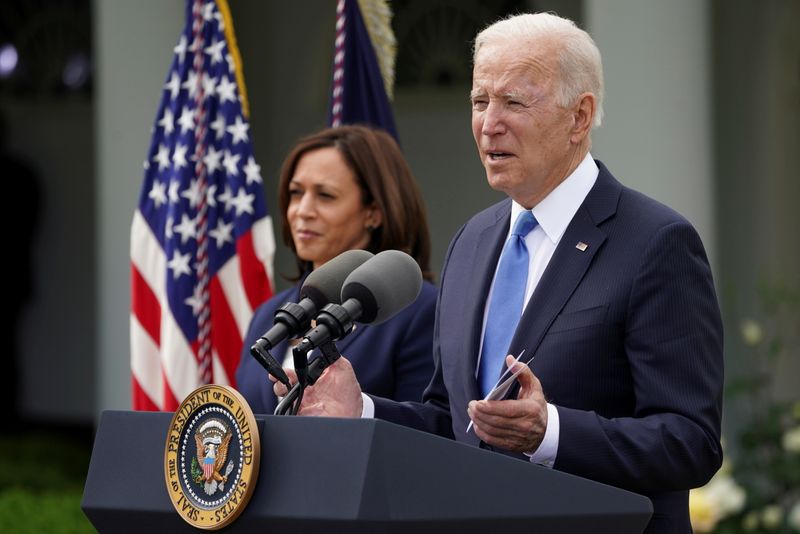(Adds FACTBOX to front of headline)
WASHINGTON (Reuters) - With more than one-third of Americans vaccinated against COVID-19, traffic is starting to re-appear in some suburbs, schools are cautiously re-opening and masks are disappearing from outside walking paths.
But the federal government in Washington, D.C., which asked most employees to work from home during the pandemic, remains largely dependent on remote work.
This may change since the U.S. Centers for Disease Control and Prevention said this week that fully vaccinated people do not need masks outdoors or in most indoor spaces. It also said that fully vaccinated people will not need to physically distance in most places. The Pentagon, for one, quickly changed its guidance regarding masks.
Follows is a look at the government's current pandemic arrangements.
White House
The White House has largely maintained most restrictions put in place because of the pandemic, including a rigorous testing regimen for its staff, which was instituted early last year.
White House staff members for the most part were vaccinated soon after President Joe Biden took office but can be seen wearing masks when moving around the West Wing. Many staff members who would normally work in the West Wing remain in the Old Executive Office Building to maintain social distancing.
Following the new guidance, Biden emerged at the White House for remarks without a mask.
The White House press corps still has a reduced presence within the press room and anyone who enters the complex or goes on a presidential trip must first be tested for COVID.
Congress:
House Speaker Nancy Pelosi said at her press conference on Thursday that members were still required to wear masks on the House floor but could remove them while delivering speeches. She conducted her press conference without a mask but promptly put it on when exiting.
Later Thursday, after the CDC guidance changed, Republican Senate leader Mitch McConnell's spokesman retweeted a photo showing the Republican leader leaving the Senate chamber maskless.
Still, tourist visits to the Capitol remain suspended.
The House of Representatives is continuing its pandemic rules of allowing members to cast their votes via another member in order to limit how many people are in the chamber during votes. Votes by the full House take much longer now as members are invited to vote in groups.
Throughout the pandemic, senators have had to show up on the floor to cast their votes.
In both the House and Senate, many congressional meetings are a hybrid of in-person and videoconferencing. Some press conferences are virtual.
Many staffers work from home, sometimes on a rotating basis with other staff members.
Supreme Court
The court remains closed to the public with no announced plans for a re-opening. There has also been no announcement on whether the next round of oral arguments will be held in-person when they take place in October.
One change that has occurred with the court's move to a videoconference is that Justice Clarence Thomas, who has been on the court since 1991 and who once went a full decade without asking a question, has become a regular participant in hearings.
Defense Department
At the Pentagon, which has 26,000 workers and more than 17 miles of corridors, officials updated the agency's guidance on Thursday to say that people who are two weeks past their last vaccination are no longer required to wear a mask, either indoors or outdoors.
State Department
The State Department has authorized the voluntary departure of family members of staff at the U.S. embassy and consulates in India, where coronavirus claimed 4,000 lives two days in a row.
The department has issued travel warnings for a long list of countries, classifying 150 of 209 as "do not travel." These include Chad, Kosovo, Kenya, Brazil, Haiti, Mozambique and Russia.
Justice Department
Two law enforcement officials told Reuters that Justice Department officials are still working remotely, though some periodically work in their offices. Any change in telework plans would come from the Office of Personnel Management, one person said.
The department includes the FBI, the Drug Enforcement Administration, the Bureau of Prisons and Bureau of Alcohol, Tobacco, Firearms and Explosives.
Department of Energy
The Department of Energy, which has about 14,000 employees and 95,000 contract workers across its offices and 17 national labs, has people working from home when possible in a "maximum telework posture" and had no update to any plans to return to full in-person work.
Federal Trade Commission
The FTC, which enforces antitrust law and rules against deceptive advertising, continues to have most of its approximately 1,100 staff under a mandatory work-from-home order, according to a spokesman, who described the current environment as an "evolving situation."
"We will continue to closely evaluate conditions on the ground in all the areas where we have offices, as well as guidance from OMB as we evaluate our telework status," the spokesman said.

Securities and Exchange Commission
The U.S. Securities and Exchange Commission, which has some 4,500 staffers, said in April that it would extend mandatory telework through Sept. 7. The SEC oversees the formation of capital, protects investors and maintains fair, orderly, and efficient markets.